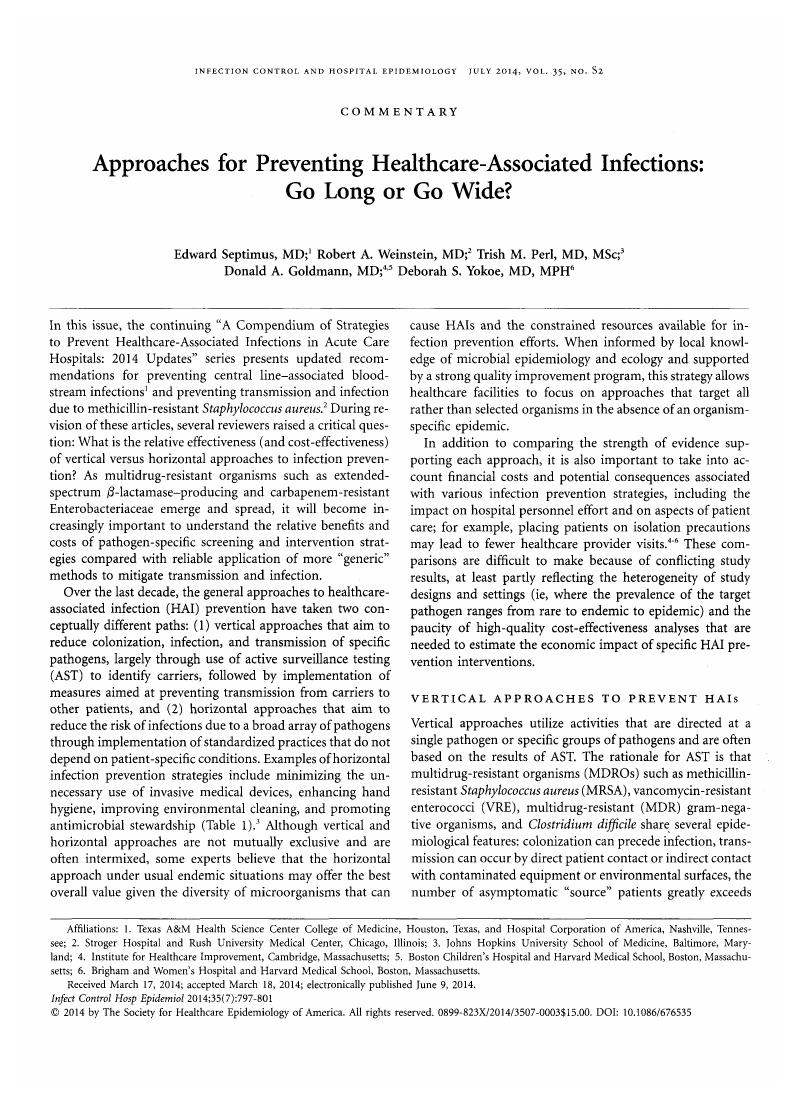Crossref Citations
This article has been cited by the following publications. This list is generated based on data provided by Crossref.
Hall, Lisa
Farrington, Alison
Mitchell, Brett G.
Barnett, Adrian G.
Halton, Kate
Allen, Michelle
Page, Katie
Gardner, Anne
Havers, Sally
Bailey, Emily
Dancer, Stephanie J.
Riley, Thomas V.
Gericke, Christian A.
Paterson, David L.
and
Graves, Nicholas
2015.
Researching effective approaches to cleaning in hospitals: protocol of the REACH study, a multi-site stepped-wedge randomised trial.
Implementation Science,
Vol. 11,
Issue. 1,
Bryce, Elizabeth
Grant, Jennifer
Scharf, Sydney
Dempster, Linda
Lau, Tim T.Y.
Laing, Felicia
Shajari, Salomeh
and
Forrester, Leslie
2015.
Horizontal infection prevention measures and a risk-managed approach to vancomycin-resistant enterococci: An evaluation.
American Journal of Infection Control,
Vol. 43,
Issue. 11,
p.
1238.
Schrank, Gregory
and
Branch-Elliman, Westyn
2017.
Breaking the Chain of Infection in Older Adults.
Infectious Disease Clinics of North America,
Vol. 31,
Issue. 4,
p.
649.
Patel, Payal K.
2017.
Applying the Horizontal and Vertical Paradigm to Antimicrobial Stewardship.
Infection Control & Hospital Epidemiology,
Vol. 38,
Issue. 5,
p.
532.
Martin, Elise
Rubin, Zachary
and
Murthy, Rekha K.
2018.
Infection Prevention.
p.
1.
Siegel, Jane D.
and
Guzman-Cottrill, Judith A.
2018.
Principles and Practice of Pediatric Infectious Diseases.
p.
10.
Riley, May Mei-Sheng
2019.
The Rising Problem of Multidrug-Resistant Organisms in Intensive Care Units.
Critical Care Nurse,
Vol. 39,
Issue. 4,
p.
48.
Wohrley, Julie D.
and
Bartlett, Allison H.
2019.
Healthcare-Associated Infections in Children.
p.
17.
Mpinda-Joseph, Pinkie
Anand Paramadhas, Bene D
Reyes, Gilberto
Maruatona, Mompoloki Buster
Chise, Mamiki
Monokwane-Thupiso, Baphaleng B
Souda, Sajini
Tiroyakgosi, Celda
and
Godman, Brian
2019.
Healthcare-associated infections including neonatal bloodstream infections in a leading tertiary hospital in Botswana.
Hospital Practice,
Vol. 47,
Issue. 4,
p.
203.
Lucet, J. C.
Harris, A. D.
and
Guidet, B.
2020.
Less contact isolation is more in the ICU: not sure.
Intensive Care Medicine,
Vol. 46,
Issue. 9,
p.
1735.
Miranda-Zazueta, Godolfino
León-Garduño, Luis A. Ponce de
Aguirre-Valadez, Jonathan
and
Torre-Delgadillo, Aldo
2020.
Bacterial infections in cirrhosis: Current treatment.
Annals of Hepatology,
Vol. 19,
Issue. 3,
p.
238.
Martin, Elise
Rubin, Zachary
and
Murthy, Rekha K.
2022.
Infection Prevention.
p.
1.
Siegel, Jane D.
and
Cantey, Joseph B.
2023.
Principles and Practice of Pediatric Infectious Diseases.
p.
9.



